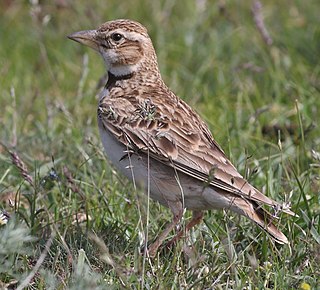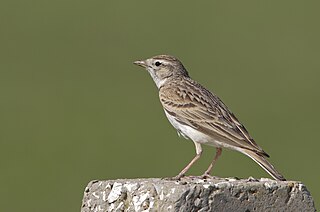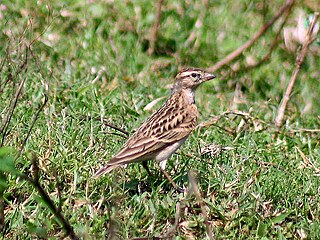
The calandra lark or European calandra-lark breeds in warm temperate countries around the Mediterranean and eastwards through Turkey into northern Iran and southern Russia. It is replaced further east by its relative, the bimaculated lark.

The bimaculated lark breeds in warm temperate countries eastwards from Turkey into Central Asia. It is the eastern counterpart of its relative, the calandra lark.

The greater short-toed lark is a small passerine bird. The current scientific name is from Ancient Greek. The genus name, Calandrella, is a diminutive of kalandros, the calandra lark, and brachydactila is from brakhus, "short", and daktulos, "toe".
Short-toed lark refers to a number of species of lark:

The Mediterraneanshort-toed lark is a small passerine bird found in and around the Mediterranean Basin. It is a common bird with a very wide range from Canary Islands north to the Iberian Peninsula and east throughout North Africa to parts of the Middle East. The International Union for Conservation of Nature has rated its conservation status as being of "least concern".

The Bengal bush lark or Bengal lark is a species of lark in the family Alaudidae found in southern Asia.

The desert lark breeds in deserts and semi-deserts from Morocco to western India. It has a very wide distribution and faces no obvious threats, and surveys have shown that it is slowly increasing in numbers as it expands its range. The International Union for Conservation of Nature has rated its conservation status as being of "least concern".

Jerdon's bush lark or Jerdon's lark is a species of lark in the family Alaudidae found in south Asia. This was formerly considered as a subspecies of Mirafra assamica and termed as the Madras bushlark. Two other species in the complex include Mirafra marionae and Mirafra microptera. Jerdon's bush lark is typically very pale on the underside

The rufous-tailed lark, also sometimes called the rufous-tailed finch-lark, is a ground bird found in the drier open stony habitats of India and parts of Pakistan. Like other species in the genus it has a large finch-like bill with a slightly curved edge to the upper mandible. The dull brown colour matches the soil as it forages for grass seeds, grain and insects. Males and females are indistinguishable in the field but during the breeding season, the male has a courtship display that involves flying up steeply and then nose-diving and pulling up in a series of stepped wavy dips accompanied by calling. They forage on the ground in pairs or small groups.

The Indian bush lark is a species of lark in the family Alaudidae found in South Asia.

The chestnut-eared bunting, also called grey-headed bunting or grey-hooded bunting, with the latter name also used for grey-necked bunting, is a passerine bird in the bunting family Emberizidae.

The red-capped lark is a small passerine bird that breeds in the highlands of eastern Africa southwards from Ethiopia and Somaliland. In the south, its range stretches across the continent to Angola and south to the Cape in South Africa.

The large-billed lark or southern thick-billed lark is a small passerine bird found in southern Africa. The name "large-billed lark" may also refer to Bradfield's lark. The name "thick-billed lark" more commonly refers to the species of the same name.

The sand lark is a small passerine bird in the lark family, Alaudidae, found in southern Asia. It is somewhat similar to, but smaller than the short-toed larks.

Sclater's lark is a species of lark in the family Alaudidae. It is found in Namibia and South Africa. Its natural habitat is subtropical or tropical dry shrubland. It is threatened by habitat loss.

The bar-tailed lark or bar-tailed desert lark is a species of lark in the family Alaudidae. Two other species, the rufous-tailed lark and the Cape clapper lark are both also sometimes referred to using the name bar-tailed lark. It is found from Morocco to Pakistan. Its natural habitat is hot deserts. This is in many places a common species, but elsewhere rather less common. It has a very wide distribution and faces no obvious threats, but surveys have shown that it is slowly decreasing in numbers. The International Union for Conservation of Nature has rated its conservation status as being of "least concern".

Calandrella is a genus of larks in the family Alaudidae.

The Somali short-toed lark is a small passerine bird of the lark family found in eastern and north-eastern Africa.

Blanford's lark or Blanford's short-toed lark is a small passerine bird of the lark family, Alaudidae, which is native to north-eastern Africa. Its common name commemorates the English zoologist William Thomas Blanford.

The Mongolian short-toed lark or Sykes's short-toed lark is a species of lark in the family Alaudidae. It breeds in China and Mongolia and winters in southern Asia.
























